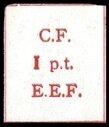Stamp: C.F. - E.E.F. (Palestine, British Mandate 1918)
C.F. - E.E.F. (Palestine, British Mandate 1918)
01 October (Palestine, British Mandate ) within release Court Fees goes into circulation Stamp C.F. - E.E.F. face value 1 Egyptian piastre
Stamp is square format.
Upright, inverted or sideways (crown pointing left or right) watermark Revenue Reverend cat. no: C11 Print run refers to a printing which was received in October 1918. There might have also been other printings for which the print run is unknown.Also in the issue Court Fees:
- Stamp - C.F. - E.E.F. face value 1;
- Stamp - C.F. - E.E.F. face value 2;
- Stamp - C.F. - E.E.F. face value 5;
- Stamp - C.F. - E.E.F. face value 10;
- Stamp - C.F. - E.E.F. face value 20;
- Stamp - C.F. - E.E.F. face value 50;
- Stamp - C.F. - E.E.F. face value 1;
- Stamp - C.F. - E.E.F. face value 2;
- Stamp - C.F. - E.E.F. face value 2;
Stamp C.F. - E.E.F. it reflects the thematic directions:
A number is a mathematical object used to count, measure, and label. The most basic examples are the natural numbers 1, 2, 3, 4, and so forth. Numbers can be represented in language with number words. More universally, individual numbers can be represented by symbols, called numerals; for example, "5" is a numeral that represents the number five. As only a relatively small number of symbols can be memorized, basic numerals are commonly organized in a numeral system, which is an organized way to represent any number. The most common numeral system is the Hindu–Arabic numeral system, which allows for the representation of any non-negative integer using a combination of ten fundamental numeric symbols, called digits. In addition to their use in counting and measuring, numerals are often used for labels (as with telephone numbers), for ordering (as with serial numbers), and for codes (as with ISBNs). In common usage, a numeral is not clearly distinguished from the number that it represents.

